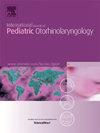Risk factors and predictive models for secondary hemorrhage in pediatric coblation tonsillectomy
IF 1.2
4区 医学
Q3 OTORHINOLARYNGOLOGY
International journal of pediatric otorhinolaryngology
Pub Date : 2025-03-25
DOI:10.1016/j.ijporl.2025.112327
引用次数: 0
Abstract
Objective
To identify risk factors for secondary post-tonsillectomy hemorrhage (SPTH) in pediatric patients undergoing Coblation procedures and develop a predictive model to support perioperative management.
Methods
A retrospective analysis was performed on 15,729 children who underwent low-temperature Coblation tonsillectomy at the Children's Hospital, Zhejiang University School of Medicine, between June 2019 and June 2024. Univariate and multivariate analysis were employed to identify factors associated with the occurrence of SPTH. A prediction model was developed based on the identified independent risk factors. To enhance the model's predictive performance and calibration, Weighted Logistic Regression was applied to construct a Nomogram model. The model was validated and evaluated using bootstrap resampling, the consistency index (C-index), Receiver Operating Characteristic (ROC) curve, and Brier Score.
Results
Among the 15,729 patients, 9834 (62.52 %) were boys, and 5895 (37.48 %) were girls.The mean age was 6.55 ± 2.38 years, and the average length of hospitalization was 3.94 ± 1.51 days. Among the 15,729 children, 235 (1.5 %) experienced SPTH, and 42 (0.3 %) required additional general anesthesia for surgical hemostasis. Univariate analysis identified that gender, age, surgical indication, degree of tonsillar embedding, Body Mass Index (BMI), postoperative diet, and surgeon experience were significantly associated with SPTH (P < 0.05).Multivariate logistic regression analysis revealed that severe tonsillar embedding, junior surgeon, obesity, poor postoperative diet, and age ≥12 years were independent risk factors for SPTH. A Nomogram model was developed based on these independent risk factors. The model was internally validated using bootstrap resampling (1000 iterations). The results showed that the C-index was 0.817, indicating good calibration and stability; ROC curve analysis revealed an Area Under the Curve(AUC)of 0.816, demonstrating strong discriminatory ability; and the Brier Score was 0.0155, indicating minimal error between predicted probabilities and actual outcomes.
Conclusion
Severe tonsillar embedding, junior surgeon, obesity, poor postoperative diet, and age ≥12 years are independent risk factors for Coblation SPTH in children. The Nomogram model can quickly and efficiently calculate the bleeding rate of SPTH in children, providing valuable guidance for clinical practice.
儿童消融扁桃体切除术继发性出血的危险因素和预测模型
目的探讨小儿扁桃体切除术后继发性出血(SPTH)的危险因素,并建立预测模型,为围手术期治疗提供支持。方法对2019年6月至2024年6月在浙江大学医学院附属儿童医院行低温消融扁桃体切除术的15729例患儿进行回顾性分析。采用单因素和多因素分析来确定与SPTH发生相关的因素。根据确定的独立危险因素建立预测模型。为了提高模型的预测性能和校准能力,采用加权Logistic回归构建Nomogram模型。采用bootstrap重采样、一致性指数(C-index)、受试者工作特征(ROC)曲线和Brier评分对模型进行验证和评价。结果15729例患者中,男孩9834例(62.52%),女孩5895例(37.48%)。平均年龄为6.55±2.38岁,平均住院时间为3.94±1.51天。在15,729名儿童中,235名(1.5%)经历了SPTH, 42名(0.3%)需要额外的全身麻醉进行手术止血。单因素分析发现,性别、年龄、手术指征、扁桃体埋置程度、体重指数(BMI)、术后饮食和外科医生经验与SPTH显著相关(P <;0.05)。多因素logistic回归分析显示,扁桃体埋深严重、初级外科医生、肥胖、术后饮食不良、年龄≥12岁是SPTH的独立危险因素。基于这些独立的危险因素建立了Nomogram模型。使用自举重采样(1000次迭代)对模型进行内部验证。结果表明,c指数为0.817,具有良好的定标性和稳定性;ROC曲线分析显示,曲线下面积(AUC)为0.816,具有较强的判别能力;Brier得分为0.0155,表明预测概率与实际结果之间的误差最小。结论扁桃体埋深严重、初级外科医生、肥胖、术后饮食不良、年龄≥12岁是儿童SPTH消融的独立危险因素。Nomogram模型能够快速有效地计算出儿童甲状旁腺激素的出血率,为临床实践提供有价值的指导。
本文章由计算机程序翻译,如有差异,请以英文原文为准。
求助全文
约1分钟内获得全文
求助全文
来源期刊
CiteScore
3.20
自引率
6.70%
发文量
276
审稿时长
62 days
期刊介绍:
The purpose of the International Journal of Pediatric Otorhinolaryngology is to concentrate and disseminate information concerning prevention, cure and care of otorhinolaryngological disorders in infants and children due to developmental, degenerative, infectious, neoplastic, traumatic, social, psychiatric and economic causes. The Journal provides a medium for clinical and basic contributions in all of the areas of pediatric otorhinolaryngology. This includes medical and surgical otology, bronchoesophagology, laryngology, rhinology, diseases of the head and neck, and disorders of communication, including voice, speech and language disorders.

 求助内容:
求助内容: 应助结果提醒方式:
应助结果提醒方式:


